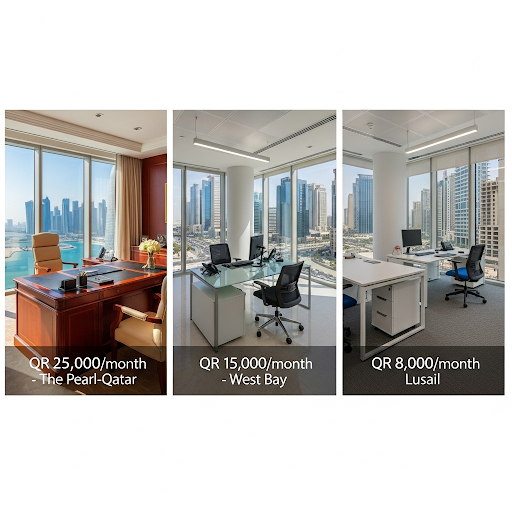location. Businesses choosing where to set up operations quickly realize that not all areas are priced the same. Demand, accessibility, and prestige play significant roles in shaping rental rates, making location the most decisive factor for office rental costs in the country.
The Role of Doha as the Commercial Hub
Doha stands at the center of Qatar’s business activity. As the capital and economic powerhouse, offices for rent here are generally more expensive compared to secondary cities or suburban areas. Central districts such as West Bay, The Pearl, and Msheireb Downtown Doha command premium rates because of their concentration of international companies, banks, and government institutions. These areas not only offer modern infrastructure but also bring prestige to businesses operating within them.
Prime Areas with Higher Rental Costs
Locations such as West Bay and The Pearl are consistently among the most expensive places for office rentals. West Bay, lined with skyscrapers and headquarters of multinational firms, offers proximity to embassies, luxury hotels, and high-end dining. The Pearl, meanwhile, is associated with exclusivity and lifestyle appeal, attracting businesses that value image as much as function. Msheireb Downtown Doha also adds to this list, being promoted as one of the world’s first smart and sustainable city districts. Offices here are technologically advanced, sustainable, and centrally located, making them high in demand and priced accordingly.
Comparing Central and Peripheral Locations
Outside of Doha’s prime business districts, office rentals become more affordable. Areas like Al Sadd, Al Hilal, or Old Airport Road offer competitive rates while still providing accessibility to the capital’s core. These locations appeal to startups, SMEs, and companies that prioritize cost efficiency over prestige. Businesses in industrial zones or suburban developments also benefit from lower rents, although they may face trade-offs in visibility and networking opportunities.
Impact of Infrastructure and Connectivity
Rental costs are not just about being in Doha but also about accessibility. Offices near metro lines, major highways, and Hamad International Airport often come at a higher price. Accessibility reduces commuting stress for employees and ensures smooth connections for clients and partners. As Qatar continues to expand its modern infrastructure, areas connected to the metro and new expressways have started seeing rent increases.
Demand from International Businesses
Qatar’s role as a global hub, especially after hosting the FIFA World Cup 2022, has fueled demand for office spaces in prestigious locations. International corporations prefer high-profile districts to align their brand with Qatar’s image as a modern and forward-thinking economy. This rising demand keeps prime areas expensive, while less central districts remain budget-friendly options.
Lusail: A Growing Alternative
Lusail City is quickly emerging as a modern alternative to Doha’s traditional business districts. Although some office rentals here are priced lower than West Bay or The Pearl, the gap is narrowing as Lusail gains recognition as a powerhouse for large-scale investments. Companies considering long-term growth often view Lusail as a strategic balance between cost and prestige.
Amenities and Work Environment Influence Pricing
Offices located within developments that offer premium amenities—such as smart technologies, high-speed internet, underground parking, and shared facilities—are naturally priced higher. Businesses often accept these costs for the sake of employee satisfaction and client perception. In contrast, smaller and older office buildings, while still functional, command lower rents because they lack such modern features.
Industrial Zones and Budget Options
For companies whose operations do not require central business visibility, Qatar’s industrial areas provide cost-effective alternatives. Locations such as the Industrial Area or Umm Salal offer significantly lower rents. These offices are practical for logistics companies, warehouses, and service providers who need space rather than prestige. The savings can be redirected into business growth, making them attractive to smaller enterprises.
The Relationship Between Location and Business Strategy
Enterprises focusing on brand presence, client interaction, and networking often invest in prime districts despite the higher costs. On the other hand, companies driven by operational efficiency and cost control find value in less central areas. The variety of locations across Qatar ensures that businesses can find a rental option aligned with their strategy.
Market Trends Shaping Office Rentals
Qatar’s office rental market continues to evolve alongside the nation’s rapid urban development. Mixed-use projects, smart cities, and sustainable building initiatives are reshaping expectations for workspaces. Companies now weigh the benefits of modern eco-friendly offices against traditional but cheaper spaces. These evolving dynamics reinforce the central truth: location remains the strongest factor influencing cost.
Choosing Offices for Rent in Qatar
When deciding where to establish a business, comparing different areas is essential. Prime districts bring visibility and prestige but require higher budgets. Secondary areas balance accessibility and affordability, while emerging zones like Lusail offer long-term growth potential. Industrial and suburban locations provide the lowest costs, though they may not suit every business model. Companies must carefully evaluate these trade-offs to make the right choice for their operations.
For a deeper look at how commercial spaces are evaluated in Qatar and what factors local and international brands must consider, you can explore this guide on retail space for rent in Qatar.
Conclusion
Offices for rent in Qatar are more expensive depending on location, with prime areas like West Bay, The Pearl, and Msheireb commanding the highest prices. Proximity to infrastructure, prestige, and international demand keep these districts at the top of the market. Meanwhile, secondary districts and industrial areas offer affordable alternatives suited for startups and cost-conscious businesses. Emerging locations like Lusail present a middle ground, blending modern infrastructure with competitive rates. For any company entering the Qatari market, location is not just an expense but a strategic decision that can define long-term success.



